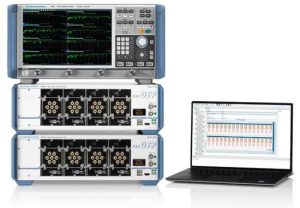Rohde & Schwarz Automated Solution to Speed Up PCIe 5.0 and 6.0 Cable and Connector Compliance Testing
With R&S ZNrun vector network analyzer automation suite option
This is a Press Release edited by StorageNewsletter.com on June 22, 2023 at 2:01 pmFor precise and time-saving compliance testing of the PCIe 5.0 and 6.0 cables and connectors in line with PCI-SIG specs, Rohde & Schwarz GmbH & Co KG is developing a R&S ZNrun vector network analyzer automation suite option.
For an automated verification of a PCIe x8 cable, for instance, the software controls a setup with R&S ZNB vector network analyzer plus scalable R&S OSP switch matrix configuration, creating a multiport VNA solution with 64 test ports. The solution reduces testing times for PCIe x8 cables to a few minutes for complete test runs with all Thru and all crosstalk combinations plus corresponding metric calculations for Pass/Fail evaluations. By comparison, manual testing takes several hours and involves major risk of connection errors by test engineers.
The company efficiently tackles compliance verification challenges for PCIe 5.0 and 6.0 cables and connectors by automating the process with a new R&S ZNrun vector network analyzer automation suite option. R&S ZNrun-K440 is designed for automatic compliance testing of PCIe 5.0 and 6.0 internal and external cables and connectors in line with PCI-SIG specs, saving users a lot of time. The test setup is based on the R&S ZNB26 or R&S ZNB43 vector network analyzer with four test ports in combination with multiple open switch and control platforms – depending on the number of the DUT lanes for verification – to provide multiple four-port measurements, all without reconnecting to the DUT and repeatedly terminating the other lanes. A PCIe x8 cable, for example, has 16 lanes and requires 64 test ports, provided by 3 R&S OSP320 platforms, while a PCIe x4 cable only needs 32 test ports from 2 R&S OSP320 platforms.
The R&S ZNrun-K440 solution automates all measurements in line with the PCIe spec. Post-processing of defined PCIe metrices is also covered. A powerful test configurator lets test items be selected and deselected by lane for greater flexibility in meeting customer needs and preferences in R&D and verification testing. A test report with a pass/fail verdict is generated at the end of the automated measurement. The automation features a new calibration procedure, which reduces number of calibration steps and calibration connections. It also includes a method for de-embedding of the test fixture as required in the PCIe test specs.
Increasingly complex test demands with PCIe evolution
Each iteration of the PCIe evolution has doubled the transfer rate to meet ever increasing demand for speed. Data centers across the world are starting to use the latest versions of PCIe 5.0 and 6.0 cables to connect large amounts of high-speed storage. Cable manufacturers are also ramping up production to deliver the first PCIe 5.0 and 6.0 cables to customers. R&D verification, compliance testing and manufacturing all require thorough testing to guarantee compliance with PCIe requirements and the proper functioning of the overall system.
Each PCIe link has 1, 2, 4, 8 or 16 lane pairs, with each lane pair consisting of one differential TX and one differential RX lane. With 8 lane pairs in a x8 configuration, a PCIe 6.0 cable can have transfer rates of up to 64GB/s. Manually verifying compliance of high-speed interconnect is labor intensive and error prone. A total of 256 4-port measurements are needed for all Thru connections and all near-end and far-end crosstalk paths inside the cable. With traditional four-port vector network analyzers, a VNA must be reconnected for each 4-port measurement and unmeasured lanes must be properly terminated. The new automated solution from the firm simplifies this process.
Since certain limit mask excursions are not critical for overall PCIe 5.0/6.0 system behavior, pass/fail verdicts are based on metrices such integrated return loss (iRL) and component contribution to integrated crosstalk noise (ccICN). They are defined in the PCI-SIG spec and need to be calculated from the S-parameter results and require significant post-processing. Calibrating test fixture characterization and de-embedding brings additional challenges. R&S ZNrun-K440 software for automatic compliance testing covers them all.
Because of their importance to PCIe systems, PCI-SIG is in the process of defining standardized cables for internal (inside a chassis) and external (chassis-to-chassis) applications, including the corresponding electrical requirements for mated cable assemblies and mated cable connectors at both 32GT/s and 64GT/s. R&S ZN-run-K440 will also cover these PCIe tests, once they are standardized.
Solution showcased at PCI-SIG Developers Conference
The company demonstrates its new automated solution for PCIe 5.0 and 6.0 cable and connector compliance testing to members of the PCI-SIG community at the PCI-SIG Developers Conference from June 13 to 14, 2023 at the Santa Clara Convention Center in Santa Clara, CA.
The R&S ZNrun-K440 option will be available soon and complements the firm’s compliance test software automation portfolio. The R&S ZNrun-K410 and R&S ZNrun-K411 options are already available for high-speed Ethernet cable assemblies in line with IEEE 802.3bj, by, cd and ck.














 Subscribe to our free daily newsletter
Subscribe to our free daily newsletter

